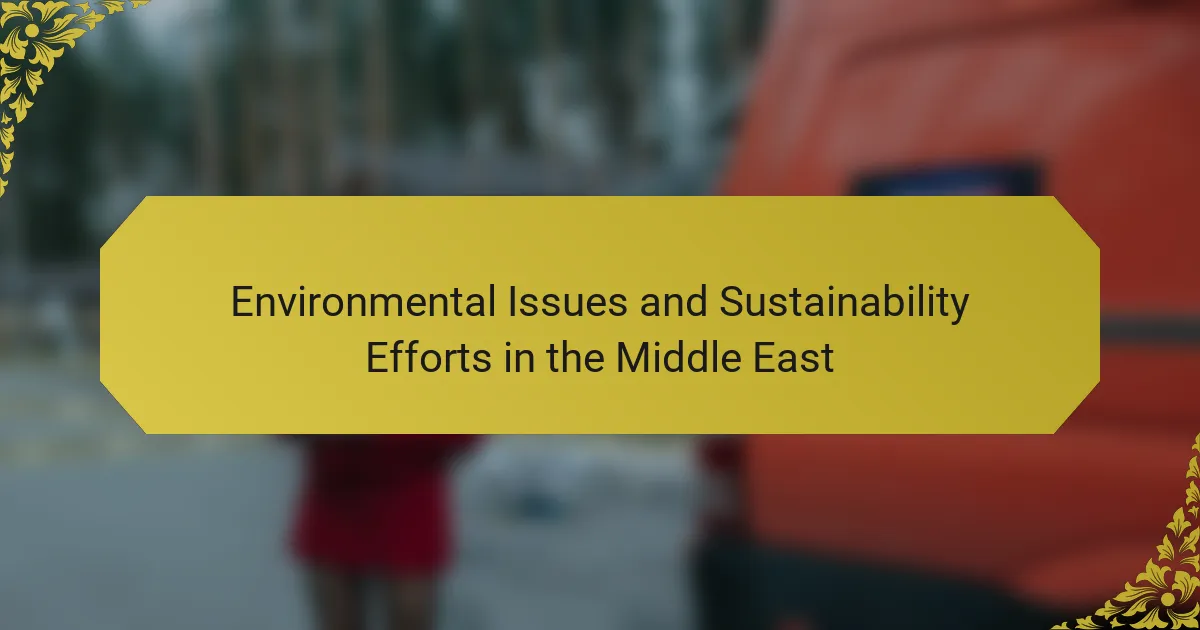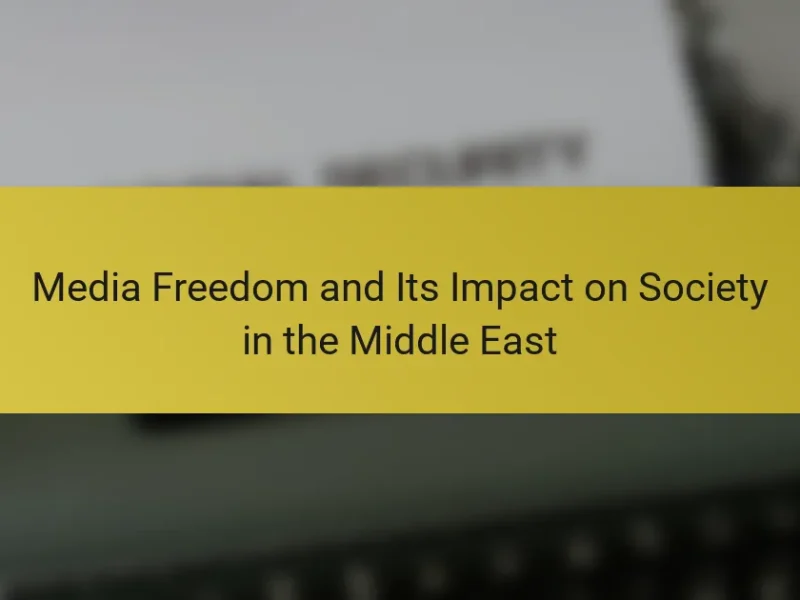
What are the key environmental issues facing the Middle East?
Key environmental issues facing the Middle East include water scarcity, air pollution, and desertification. Water scarcity affects agriculture and drinking supplies. The region has some of the lowest freshwater resources per capita globally. Air pollution results from industrial activities and vehicle emissions. Major cities frequently exceed safe air quality levels. Desertification threatens arable land and biodiversity. Climate change exacerbates these issues, leading to more extreme weather patterns. The Intergovernmental Panel on Climate Change (IPCC) reports increasing temperatures and reduced precipitation in the region. These environmental challenges significantly impact health, food security, and economic stability.
How do climate change and water scarcity impact the region?
Climate change and water scarcity significantly impact the Middle East region. Rising temperatures lead to increased evaporation rates and decreased water availability. This exacerbates existing water scarcity, affecting agriculture and food security. According to the World Bank, the region could face a 50% reduction in renewable water resources by 2050. Water scarcity also drives conflicts over resources, increasing regional instability. Additionally, climate change affects biodiversity and ecosystems, further compromising natural resources. These factors collectively threaten the livelihoods of millions in the region.
What are the effects of rising temperatures on agriculture in the Middle East?
Rising temperatures significantly affect agriculture in the Middle East. Increased heat leads to reduced crop yields. Higher temperatures can cause heat stress in plants. This stress impacts photosynthesis and growth rates. Water scarcity exacerbates these effects, as evaporation rates increase. Crop irrigation demands rise under hotter conditions. Many regions face challenges in maintaining soil moisture. Additionally, pests and diseases thrive in warmer climates, threatening crops. These factors collectively jeopardize food security in the region.
How does water scarcity affect urban development and population growth?
Water scarcity significantly hinders urban development and population growth. Limited access to water resources restricts infrastructure development. Cities require reliable water supply for residential, commercial, and industrial activities. When water is scarce, economic growth slows down. This leads to decreased job opportunities and migration challenges. For instance, in the Middle East, rapid urbanization coincides with declining water availability. According to the World Bank, the region faces severe water stress, affecting over 60% of its population. Consequently, urban areas may experience population stagnation or decline. Water scarcity also exacerbates social inequalities and conflicts over resources.
What role does pollution play in the environmental landscape of the Middle East?
Pollution significantly impacts the environmental landscape of the Middle East. Air pollution levels in cities like Cairo and Tehran often exceed World Health Organization guidelines. This pollution affects human health, contributing to respiratory diseases and premature deaths. Water pollution from industrial discharge and agricultural runoff contaminates vital water sources. The region’s unique geography exacerbates the effects of pollution, trapping pollutants in urban areas. Desertification is accelerated by pollution, leading to loss of arable land. Additionally, oil spills from maritime activities threaten marine ecosystems in the Persian Gulf. The interplay of these factors underscores the urgent need for sustainable practices in the region.
What are the primary sources of air and water pollution in the region?
The primary sources of air and water pollution in the region include industrial emissions, agricultural runoff, and urban waste. Industrial emissions release pollutants such as sulfur dioxide and nitrogen oxides into the air. Agricultural runoff often contains fertilizers and pesticides that contaminate water sources. Urban waste contributes to both air and water pollution through improper disposal and sewage discharge. According to the World Bank, these factors significantly impact public health and environmental quality in the Middle East.
How does pollution impact public health and ecosystems?
Pollution significantly impacts public health and ecosystems. Air pollution, for example, leads to respiratory diseases, cardiovascular issues, and premature deaths. According to the World Health Organization, outdoor air pollution caused around 4.2 million deaths globally in 2016. Water pollution affects drinking water quality, leading to gastrointestinal diseases and other health problems. Contaminated water sources can also disrupt aquatic ecosystems, harming fish and other wildlife. Soil pollution reduces agricultural productivity and contaminates food supplies. The degradation of ecosystems threatens biodiversity and disrupts natural processes. These health and ecological effects highlight the urgent need for pollution control measures.
Why is biodiversity loss a critical concern in the Middle East?
Biodiversity loss is a critical concern in the Middle East due to its impact on ecosystems and human livelihoods. The region is home to unique species and habitats that are increasingly threatened by climate change and urbanization. Over 50% of the Middle East’s biodiversity is at risk, according to the United Nations Environment Programme. This loss can disrupt food security, as many communities rely on local flora and fauna for sustenance. Furthermore, biodiversity supports ecosystem services such as water purification and soil fertility. The degradation of natural habitats can lead to increased desertification, which affects agriculture and water resources. Protecting biodiversity is essential for maintaining ecological balance and resilience in the face of environmental challenges.
What are the main drivers of biodiversity loss in the region?
The main drivers of biodiversity loss in the region include habitat destruction, pollution, overexploitation, invasive species, and climate change. Habitat destruction occurs primarily due to urbanization and agricultural expansion. This leads to the fragmentation of ecosystems and loss of species. Pollution from industrial activities and agricultural runoff degrades water and soil quality. Overexploitation of natural resources, such as overfishing and logging, reduces species populations. Invasive species disrupt local ecosystems and outcompete native species. Climate change alters habitats and affects species’ survival. These factors collectively threaten the region’s biodiversity.
How does habitat destruction affect wildlife populations?
Habitat destruction significantly reduces wildlife populations. It leads to loss of food sources, shelter, and breeding grounds. Fragmented habitats isolate animal groups, hindering genetic diversity. This isolation increases vulnerability to extinction. According to a study by the World Wildlife Fund, habitat loss has contributed to a 68% decline in global wildlife populations since 1970. In the Middle East, urbanization and agriculture are primary drivers of habitat destruction. The region’s unique biodiversity is at risk due to these activities.

What sustainability efforts are being implemented in the Middle East?
The Middle East is implementing various sustainability efforts across the region. Countries are investing in renewable energy projects, particularly solar and wind energy. For instance, the UAE aims to generate 50% of its energy from clean sources by 2050. Saudi Arabia’s Vision 2030 includes plans to diversify energy sources and reduce dependence on oil. Water conservation initiatives are also a priority, with countries investing in desalination technologies. The Kingdom of Bahrain has launched programs to improve water efficiency and reduce waste. Additionally, there are efforts to enhance green spaces in urban areas, such as the Qatar National Vision 2030 promoting sustainable urban planning. These initiatives reflect a broader commitment to environmental sustainability in response to climate change challenges.
How are governments addressing environmental challenges?
Governments are addressing environmental challenges through regulations, initiatives, and international cooperation. They implement laws to reduce pollution and protect natural resources. Many governments invest in renewable energy projects to decrease reliance on fossil fuels. For instance, the UAE’s Energy Strategy 2050 aims to increase clean energy’s contribution to the total energy mix to 50%.
Additionally, governments promote sustainable agriculture practices to conserve water and reduce land degradation. They also create protected areas to preserve biodiversity and ecosystems. Internationally, Middle Eastern governments participate in agreements such as the Paris Agreement to combat climate change.
By taking these actions, governments aim to create a sustainable future for their populations while addressing pressing environmental issues.
What policies have been introduced to combat climate change?
Governments in the Middle East have introduced various policies to combat climate change. These policies include renewable energy initiatives, such as solar and wind projects. For instance, the UAE’s Energy Strategy 2050 aims to increase clean energy’s contribution to 50% of its total energy mix. Additionally, Saudi Arabia’s Vision 2030 emphasizes diversifying the economy and increasing reliance on renewable sources. Many countries have also implemented carbon pricing and emission reduction targets. The Qatar National Vision 2030 promotes sustainable development and environmental protection. These policies reflect a commitment to addressing climate change challenges in the region.
How do renewable energy initiatives contribute to sustainability?
Renewable energy initiatives contribute to sustainability by reducing greenhouse gas emissions. They provide clean energy alternatives to fossil fuels. This transition decreases air pollution and mitigates climate change effects. For instance, solar and wind energy systems produce electricity without harmful emissions. According to the International Renewable Energy Agency, renewable energy could reduce global CO2 emissions by up to 70% by 2050. Additionally, these initiatives promote energy independence and security. They create jobs in the green technology sector, fostering economic growth. This shift also supports biodiversity by minimizing habitat destruction associated with traditional energy sources. Overall, renewable energy is essential for achieving long-term sustainability goals.
What role do NGOs and community organizations play in sustainability efforts?
NGOs and community organizations play a crucial role in sustainability efforts. They facilitate local engagement in environmental initiatives. These organizations often raise awareness about sustainability issues. They provide education on resource conservation and environmental protection. NGOs also advocate for policies that promote sustainable practices. They often collaborate with governments and private sectors to implement projects. Many NGOs focus on specific areas like water management or renewable energy. Their efforts can lead to measurable improvements in local ecosystems. For example, research shows that community-led initiatives can increase recycling rates by up to 30%.
What projects are NGOs undertaking to promote environmental awareness?
NGOs are undertaking various projects to promote environmental awareness. These include community education programs about sustainability and conservation. Workshops on waste management and recycling are also common. Many NGOs conduct tree planting initiatives to enhance local ecosystems. Campaigns to reduce plastic use and promote alternative materials are prevalent. Some organizations focus on protecting endangered species through awareness campaigns. Others facilitate clean-up drives in local communities to foster environmental stewardship. Research shows that educational initiatives can significantly increase public awareness and engagement in environmental issues.
How do community-led initiatives support conservation efforts?
Community-led initiatives support conservation efforts by engaging local populations in environmental stewardship. These initiatives often foster a sense of ownership and responsibility towards natural resources. For example, community members may organize clean-up drives or tree-planting events. Such activities directly enhance local biodiversity and habitat restoration. Research shows that areas with active community participation see improved conservation outcomes. Communities often possess traditional ecological knowledge that informs sustainable practices. This localized knowledge can lead to more effective conservation strategies. Additionally, these initiatives can attract funding and resources from external organizations. Overall, community involvement is crucial for the success of conservation efforts.
What innovations are emerging in sustainable practices in the region?
Innovations in sustainable practices in the Middle East include advancements in solar energy technology and water conservation methods. Solar energy projects, such as large-scale solar farms, are being developed to harness the region’s abundant sunlight. For instance, the Mohammed bin Rashid Al Maktoum Solar Park in Dubai aims to produce 5,000 MW by 2030. Water conservation innovations involve smart irrigation systems that optimize water use in agriculture. These systems can reduce water consumption by up to 50%. Additionally, waste management practices are evolving with the introduction of recycling initiatives and waste-to-energy plants. The region is also investing in green building technologies to enhance energy efficiency in construction.
How is technology being leveraged to enhance water management?
Technology is being leveraged to enhance water management through smart irrigation systems and real-time monitoring. Smart irrigation systems use sensors to optimize water usage based on soil moisture levels. This approach can reduce water waste by up to 50%. Real-time monitoring technologies, such as IoT devices, track water quality and availability. These devices enable immediate responses to changes in water conditions. Data analytics also play a critical role in predicting water demand and managing resources efficiently. Geographic Information Systems (GIS) help visualize water distribution and identify areas for improvement. These technologies collectively contribute to more sustainable water management practices in the Middle East.
What are the successes and challenges of urban sustainability projects?
Urban sustainability projects have achieved significant successes, including improved energy efficiency and enhanced public transportation systems. These initiatives have led to reduced greenhouse gas emissions and better air quality in cities. For instance, the implementation of green building standards in cities like Dubai has resulted in energy savings of up to 30%. However, challenges persist, such as funding constraints and stakeholder engagement issues. Many projects struggle to secure adequate financing, limiting their scope and effectiveness. Additionally, public resistance to change can hinder the adoption of sustainable practices. Reports indicate that over 50% of urban sustainability initiatives face delays due to lack of community support. Overall, while urban sustainability projects show promise, their success is often tempered by financial and social obstacles.

What are the future prospects for environmental sustainability in the Middle East?
The future prospects for environmental sustainability in the Middle East are increasingly positive due to several strategic initiatives. Governments are investing in renewable energy sources, such as solar and wind power. For instance, Saudi Arabia aims to generate 58.7 GW of renewable energy by 2030. Water conservation technologies are also being prioritized, addressing water scarcity issues prevalent in the region. Countries like the UAE are implementing advanced desalination processes and wastewater recycling. Additionally, regional collaborations on environmental policies are strengthening sustainability efforts. The Middle East is also focusing on reducing carbon emissions as part of international climate agreements. These actions indicate a commitment to improving environmental sustainability in the region.
How can regional cooperation enhance sustainability efforts?
Regional cooperation can enhance sustainability efforts by fostering shared resources and knowledge. Collaborative projects can lead to more efficient use of water and energy. For instance, joint efforts in water management can address scarcity issues prevalent in the Middle East. Studies show that countries working together can reduce costs and improve outcomes. Regional partnerships can also promote the exchange of best practices in renewable energy. This can accelerate the transition to sustainable energy sources. Additionally, cooperation can strengthen policy frameworks for environmental protection. By aligning regulations, countries can tackle transboundary environmental challenges more effectively.
What collaborative initiatives are being pursued among Middle Eastern countries?
Middle Eastern countries are pursuing several collaborative initiatives focused on environmental issues and sustainability. One notable initiative is the Arab Climate Change Action Plan, which aims to enhance regional cooperation on climate adaptation and mitigation. Another is the Gulf Cooperation Council’s (GCC) efforts to develop a unified strategy for renewable energy deployment. The Middle East Green Initiative promotes afforestation and aims to plant 10 billion trees across the region. Additionally, the Regional Center for Renewable Energy and Energy Efficiency facilitates knowledge sharing among member countries. These initiatives are supported by various agreements, including the Paris Agreement, which emphasizes collective action against climate change.
How can shared resources address common environmental challenges?
Shared resources can effectively address common environmental challenges by promoting collaboration and efficient use of assets. By pooling resources, communities can reduce waste and lower costs associated with environmental management. For instance, shared water management systems can enhance water conservation efforts in arid regions. Collaborative initiatives like community gardens can improve local biodiversity and food security. Research indicates that shared renewable energy projects can decrease carbon emissions significantly. A study by the International Renewable Energy Agency (IRENA) found that cooperative solar energy initiatives can increase energy access while reducing environmental impacts. These strategies demonstrate that shared resources can lead to sustainable solutions for pressing environmental issues.
What can individuals do to contribute to sustainability in the Middle East?
Individuals can contribute to sustainability in the Middle East by adopting eco-friendly practices. They can reduce water consumption by using efficient fixtures and fixing leaks. Recycling waste helps minimize landfill use and promotes resource recovery. Supporting local and sustainable agriculture reduces carbon footprints associated with food transport. Using public transportation or carpooling decreases greenhouse gas emissions. Individuals can also engage in community clean-up initiatives to enhance local environments. Educating others about sustainability fosters a culture of environmental responsibility. According to a report by the United Nations Environment Programme, these actions collectively can lead to significant environmental improvements.
What are effective practices for reducing personal environmental impact?
Effective practices for reducing personal environmental impact include reducing waste, conserving energy, and using sustainable transportation. Individuals can minimize waste by recycling and composting. Energy conservation can be achieved by using energy-efficient appliances and turning off lights when not in use. Sustainable transportation options include walking, biking, carpooling, or using public transit. According to the United Nations Environment Programme, these practices significantly lower carbon footprints. Engaging in local environmental initiatives also fosters community awareness and action.
How can community engagement foster a culture of sustainability?
Community engagement fosters a culture of sustainability by encouraging collective action and shared responsibility. When individuals participate in local sustainability initiatives, they develop a sense of ownership. This ownership motivates them to adopt sustainable practices in their daily lives. Engaged communities can share knowledge and resources, amplifying the impact of sustainability efforts. Events like clean-up drives and workshops raise awareness about environmental issues. Research indicates that communities involved in sustainability projects report higher levels of environmental stewardship. For example, a study by the United Nations Development Programme highlights successful community-led initiatives in the Middle East that have improved local ecosystems. Engaging community members creates a network of support, making sustainable practices more accessible and effective.
The main entity of this article is the environmental issues and sustainability efforts in the Middle East. Key environmental challenges include water scarcity, air pollution, and desertification, all exacerbated by climate change. The article explores the impacts of these issues on agriculture, urban development, and public health, as well as the drivers of biodiversity loss. It also highlights sustainability initiatives being implemented by governments and NGOs, such as renewable energy projects and community engagement efforts, aimed at addressing these pressing environmental concerns. Additionally, the article discusses the role of technology and regional cooperation in enhancing sustainability practices across the region.


